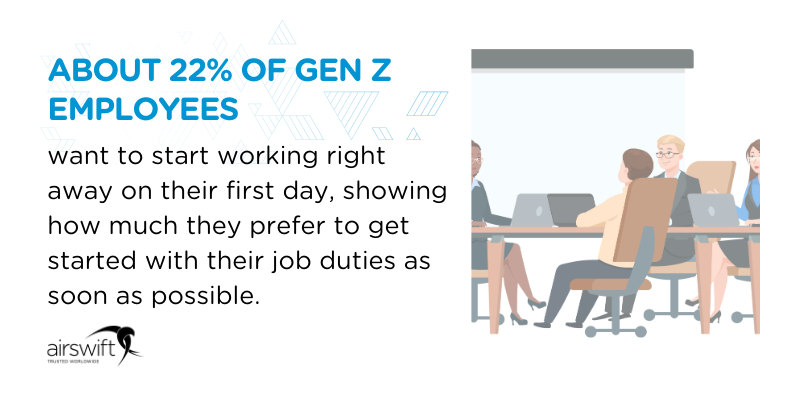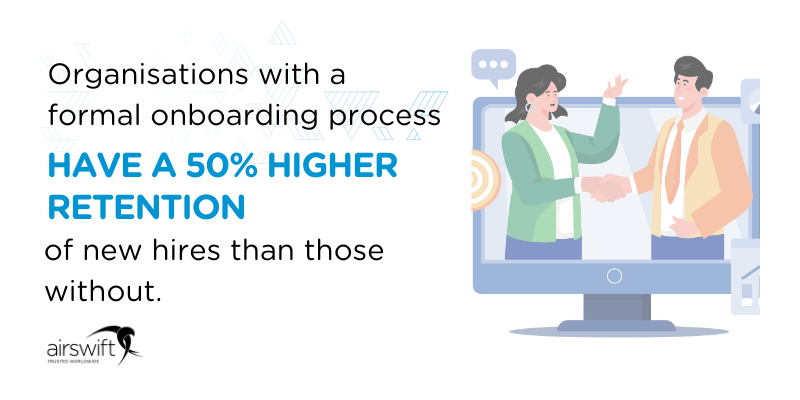
By
Diyaa Mani
April 2, 2025
Updated
September 30, 2025
First impressions matter—especially when it comes to onboarding new employees. Research shows that organisations with a structured onboarding process see 50% higher retention rates compared to those without. A strong start not only helps new hires integrate seamlessly into the team but also lays the foundation for their long-term success and job satisfaction.
Yet, many companies stumble in this critical phase. Poor onboarding can lead to confusion, frustration, and early turnover, costing businesses time and money. The good news? These pitfalls are avoidable with the right strategies.
Below are some of the common onboarding mistakes and how to avoid them.
Delaying onboarding and lack of preparation
Starting the employee onboarding process too late or failing to prepare essential resources can be costly when hiring STEM professionals. To avoid this, implement a robust pre-boarding process. This involves setting up IT systems, providing necessary tools, ensuring a fully equipped workspace is ready before the employee's first day and other essential resources for an effective onboarding process.
By doing so, you not only save time but also boost new hire engagement and retention. A well-executed pre-boarding strategy results in an increase in employee retention by up to 82% and reduces non-starters, making it a crucial step in securing top talent in a competitive STEM job market
Lack of structure and clear expectations
One of the biggest onboarding mistakes when hiring STEM professionals is failing to provide a structured process with clear goals and expectations. This oversight can lead to confusion and frustration among new hires, ultimately affecting their productivity and job satisfaction.
To avoid this, it is crucial to define specific roles, responsibilities, company policies, and success metrics from the outset. Use job descriptions to craft a clear vision and mission statement for the role and establish measurable goals for key milestones, such as 30 and 90 days.
A well-structured, effective onboarding process boosts employee engagement and retention and accelerates time-to-productivity, significantly improving overall business performance.
Information overload

One of the most common pitfalls when onboarding new STEM professionals is bombarding them with too much information at once. This can lead to confusion, frustration, and a slower integration into the team.
To avoid this, it's essential to distribute information gradually over time. Start by prioritising key details that new hires need to know immediately and then introduce progressively more information as they settle into their roles. Regular check-ins with constructive feedback are also crucial, as they provide ongoing support and address any questions or concerns.
This approach enhances new hire satisfaction and boosts productivity and retention, ultimately benefiting the organisation. Leveraging digital tools and training modules can further streamline this process, allowing for phased information release and personalised content tailored to each employee's needs.
For instance, learning management systems (LMS) can be used to deliver training modules in a structured sequence, ensuring that new hires receive relevant information at the right time. Additionally, online onboarding platforms can provide interactive checklists and automated reminders, helping to keep the onboarding process organised and on track while reducing administrative burdens.
Insufficient training
Another common mistake when onboarding STEM professionals is assuming they're already familiar with company-specific processes, systems, and training materials. This oversight can lead to confusion and a slower integration into the team. Comprehensive training tailored to your company's unique practices and technologies is essential to address this.
This approach ensures a smooth transition for new hires, builds their confidence in their roles and accelerates their time-to-productivity. By offering training that covers both technical skills and company-specific procedures, you can help STEM professionals adapt quickly and effectively.
This enhances job satisfaction and creates a more efficient and innovative work environment.
Ignoring cultural and generational differences

Using a one-size-fits-all approach when onboarding new STEM professionals without considering cultural or generational differences can lead to disengagement and a lack of connection with the company culture. It's crucial to personalise the onboarding experience by acknowledging and addressing these differences to avoid this.
For instance, younger generations, such as Millennials and Gen Z, often prefer flexible work arrangements and digital communication, while older generations may value more traditional methods.
Similarly, cultural differences can influence how employees interact and respond to feedback. By embracing these differences, you can foster a more harmonious and productive work environment that values diversity and promotes employee satisfaction. This approach enhances new hire engagement and contributes to a more innovative and competitive organisation.
Lack of feedback and continuous support
Failing to provide regular feedback or ongoing support when onboarding new STEM professionals can leave new hires uncertain about their performance and unsupported in their roles. To address this, it's essential to implement a feedback loop where managers offer continuous coaching and recognition of achievements.
Organisations can foster a positive and supportive work environment by regularly checking in with new hires, providing constructive feedback, and acknowledging their accomplishments. This approach encourages personal and professional growth and boosts employee engagement and retention. Continuous support helps STEM professionals feel valued and motivated, increasing job satisfaction and productivity.
No clear path to growth
Failing to outline continuous development opportunities can lead to disengagement and turnover as talented individuals seek growth and advancement elsewhere. Providing a clear development plan during the onboarding process is essential to address this. This plan should include training programs, mentorship opportunities, and well-defined career progression paths.
In the competitive STEM job market, where many professionals aim to progress their careers, providing a clear path to advancement is crucial. This approach benefits employees by helping them achieve their career goals and strengthens your organisation by fostering a culture of continuous learning and innovation.
Unlocking success in a competitive market

Onboarding STEM professionals requires a thoughtful and structured approach that addresses these highly skilled individuals' unique needs and expectations. Implementing a well-designed onboarding process enhances employee satisfaction and retention and contributes to a more productive and innovative work environment and employee experience.
As the competition for STEM talent continues to grow, investing in effective onboarding strategies will become increasingly crucial for companies seeking to stay ahead in their respective industries.
Following are 10 effective onboarding strategies to attract STEM talent:
- Set expectations early: During recruitment, clearly define workload, hours, and success metrics to prevent confusion and burnout.
- Create a worker checklist: Use detailed, tailored checklists to ensure smooth onboarding.
- Digitise paperwork: Utilise tools like DocuSign for efficient and secure document handling.
- Introduce them to the team: Facilitate team introductions via face-to-face meetings, video calls, and internal communication tools to build connections.
- Assign a work friend: Pair new hires with an experienced colleague for guidance and support.
- Organise physical/virtual Socials: Host informal gatherings or video calls to help new employees bond with the team personally.
- Schedule one-on-ones and meetings: Plan regular check-ins to monitor progress and foster communication.
- Provide a clear work plan: Share goals, tasks, and expectations to guide their contributions effectively.
- Gather feedback: Continuously refine the onboarding process based on input from new hires.
- Follow up regularly: Support new hires over time to ensure they acclimate successfully and feel engaged.
Read our blog on effective onboarding strategies here.
Hire and manage your workforce with ease
Leveraging global workforce solutions can be invaluable for companies seeking to streamline their hiring and onboarding processes. We specialise in connecting exceptional talent with leading organisations across the technical and engineering sectors. Visit our workforce solutions page to explore how our comprehensive workforce solutions can support your business growth.

